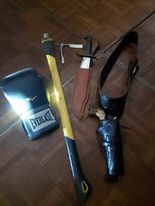The newest volume [#35] of The Black Box Project covers a tremendously useful attack called Switching
or “Switching ‘em up” among various other names.
It IS NOT the grappler’s switch—a formidable
weapon itself with myriad applications and variations.
This volume is ALL striking, ALL on the
feet.
We begin with the elements that comprise
all switch attacks that contribute to making it a go-to for
·
A significant increase in power via the Power
Bump.
·
A contralateral Speed Enhancer.
·
A force multiplier via the Forced Collison
·
A beautiful “Ambush” for ring or street.
We take a historical walk
through the different applications of the tactic from roughly 1820 through
approximately 1933.
·
Covered are 4 Ring-Legal Applications.
·
6 Empty-Hand Rough ‘n’ Tumble Applications
[Some from the early Street Dentist tradition.]
·
2 more “Connected” variations for the
street.
·
2 Knife-Fighting specific applications + 1
more for Straight Razor.
·
3 Saloonkeeper Specials using an
ax-handle, cudgel, tire iron, hell, whatever is at your disposal.
·
And 3 Close-Quarters Firearm/Gunfighter applications.
I will demo with my beloved six-guns how it was originally done, but your carry
of choice will work just fine.
To snag your copy for
the August discount price click here.
To learn more about
this whole Black Box Project Historical Mayhem Brotherhood and save yourself
some moolah, well, have a look-see here: The Black Box Project Lowdown
To hear my dulcet voice
drone on about historical mayhem, try our podcast

Comments
Post a Comment